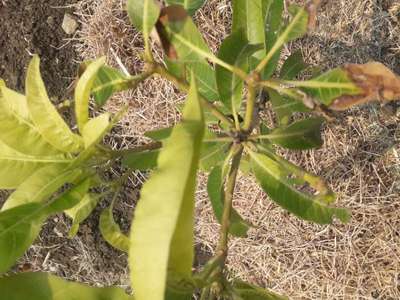Mango Blossom Diseases
A large number of posts regarding the floral diseases of mango in Plantix, I wish to put this post for answer of the quaries.
Powdery mildew and blossom blight or anthracnose are the most important diseases infecting mango plant at the time of flowering and fruit set thus causing severe losses to mango crop.
Powdery mildew affecting mango inflorescence is characterised by greyish white or whitish colour talc-like haze and it may cover the inflorescence partially or entirely, leading to reduced fruit set or complete failure of the crop. It affects the young developing fruits also.
This disease is caused by a fungus named as Pseudoidium anacardii (Oidium mangiferae). In different developmental stages of panicle/ inflorescence, no infection occurs up to protected stage (elongated inflorescence still protected by bracts), even when the disease level reached the peak on other inflorescence in the field. When the axes of the inflorescence changes from green colour to red colour, the inflorescence become slowly susceptible to powdery mildew i.e., from the protected stage susceptibility increases and the full bloom stage is the most susceptible stage.
Powdery mildew symptoms can be diagnosed in the field when around 20% of the inflorescence attained red coloured and red open stage. Hence, it is better to start the fungicide application before or at the time when 50% of the inflorescence attain full bloom stage if there is a history of occurrence of powdery mildew in previous year.
The flowers killed by powdery mildew will turn brown and can be crumbled easily by one’s hand. Less often, powdery and necrotic lesions will be seen on the young leaves mostly on the areas adjacent to midrib but the older leaves are resistant to infection.
Adoption of control measures assumes significance as this disease, if not controlled at right stage, may lead to total loss in yield. This disease can be managed by using integrated disease management strategy.
Following of some cultural practices like pruning of diseased inflorescences/ panicles at initial stages, and improved aeration and sun light penetration in the tree canopy may minimise pathogen inoculum. None of the known mango cultivars so far has been found immune to the disease.
The most effective way to control mango powdery mildew on commercial cultivar is to apply well timed fungicide sprays. And it should be continued once or twice after the first spray once in 2 weeks depending upon the disease severity until fruit set. Spray of wettable sulphur 0.2% (2gm/litre of water) provides reasonable control but it may cause phyto-toxicity, i.e., it may burn flowers and young fruits if sprays are applied during hot sunny days.
Further, due to increased disease pressure, sulphur could not offer satisfactory control of powdery mildew. Hence, spraying of Dinocap (@1gm/L) or Tridemorph (@1gm/L) can be done alternatively once in two weeks till fruit set stage.
Recently, apart from theses some new fungicides like Hexaconazole (0.5ml/L), Penconazole (0.5ml/L), Flusilasole(0.4ml/L), Myclobutanil (1gm /L) are also proved to be effective against mango powdery mildew, which are available in different trade names in market. If this disease is at advanced stage, it may be too late for any control measures to have effect on fruit set and yield; hence timely application of fungicide is very important to protect the mango from harmful effect of powdery mildew.
High pressure spraying equipment will effectively deliver the fungicide to the top of tree. But continuous use of specific systemic fungicide has to be avoided since it may develop resistance in powdery mildew pathogen population.
In some regions, both powdery mildew and hopper occur together. In such cases, a combined treatment of suitable fungicide and insecticide also recommended.
 + 22
+ 22Anthracnose of Papaya and Mango
 Upvote
Upvote Downvote
Downvote




Sali 412182
412182
5 years ago
Na_Patil Your mango plant seems like that it might be associated with আয়রনের অভাবজনিত রোগ, so you can review at plantix library by clicking on green text.
Do you have a question too?
Join the biggest agricultural online community now and get the help you need!
Get Plantix now for free!Dhiraj 138367
138367
5 years ago
Na_Patil Use the above recommendations for better growth of the plant.
Shanmuga 67621
67621
5 years ago
இரும்புச்சத்து குறைபாடு Click on above green link so that we can get detail information along with control measures in Plantix library. Na_Patil thank you